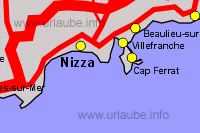|
|
Nice - The Capital of the Côte d'Azur
By talking about the Côte d'Azur and its famous places, most of the times, the places Nice, Cannes and Monaco are named in the same vein, whereby most of the times, Nice is named as the fist city. With more than 400.000 inhabitants, and a huge airport, Nice is also the undoubted city of the whole region. But Nice is in any case not the official capital of of the whole Côte d'Azur; the right as a capital is limited to the Département Alpes-Maritimes that goes alongside the coast from Menton up to Cannes. Moreover, no person of Monaco would appreciate the fact that a city that is only the capital of one of the Départements of France would be positioned above the independent State of Monaco. In order to be able to fully enjoy Nice, one should have a look into the long city history that contains several surprising events. By having a look into the history, one also understands why there are so few relicts of the medieval or antique times in Nice. History of NiceNormally, the history of the small city at the Côte d'Azur starts with the Roman times or even some centuries before with the Greeks. But in Nice, the beginning was considerably long time before this: at the west of the mountain Berge Mont Alban and Mont Baron, thus at the east of the city, the traces of a former colony were found that is approximately one million years old. Further findings that are ten thousand, fifty thousand or even several hundred thousands years old proof that the region of Nice had been continuously inhabitated. Therewith, Nice is one of the oldest permanently known colonies of the human beings par excelence! 
But the actual city history for us begins - as expected - approximately 500 years BC, when the Greek Phocaea, who founded Marseille a century ago, founded a trade centre named Nikaia. At approximately 150 BC, the Romans settled in the neighboured place Cimiez (Cemenelum in Latin). While during the Roman period, Cimiez soon grew to several thousands of inhabitants, the actual Nice only served as a harbour. But in the confusion of migration, Cimiez remained behind and the smaller Nice got established in the region. Also during the medieval times, the happenings of the region focused on Nice, as Nice was easier to fortificate and defend due to its surrounding mountains. Today, the antique Cimiez is a city district of Nice; still today, some traces of the Roman times as for example the amphitheatre can be viewed. 
In the year 1388, a disastrous decision was taken in Nice: the population got split from France and subordinated the Earl of Savoyen, even though geographically, Nice was clearly divided from Savoyen by the Alps. Therewith, numerous conflicts and arguments during the following centuries were preprogrammed. The city was reconquered several times. Also the sun-god Ludwig XIV could not achieve to conquer Nice permanently. Due to the destructions that were related to the wars conquest, today, there are only a few antique and medieval monuments and buildings remaining. But the connection to Savoyen not only provided a war and destruction but also an economical recession. As for Savoyen, Nice was only an external county, the Italians put more emphasis to their harbour Genua than to the distant Nice. Not until the year 1860, Nice returned together with Menton back to France after belonging nearly half a millenium to Italy . Finally, an economical boom took place the way it began long time ago in the neighboured areas. Soon, Nice developed to the biggest tourist metropolis of southern Europe. Alongside the Promenade des Anglais, rich people from all over the world got settled, while the local people lived in the oldtown under miserable circumstances. Even though in the beginning of the 20th century, Cannes outdid Nice a little concerning posh tourism, the city permanently continued developing to the biggest tourism and economic centre at the Côte d'Azur. Nice in the 21st CenturyToday, Nice is a city second to none. Nice is the capital of the Département Alpes-Maritimes and with more than 400.000 inhabitants, it is the second biggest city at the southern coast of France. Nice has the second biggest airport of France and forms with its surroundings the biggest economic and business centre of the whole Côte d'Azur. Nice is also the city with the most tourists and the most hotels. There is also no other city in France except Paris with more museums than Nice. 
Nice presents itself as a modern big city where one never loses the overview. No matter at which place of the city one is currently located, one will always be able to look through the houses to the sea and therewith recuperate the orientation. In Nice, one can loaf for hours through the oldtown, museums and modern shops; and if one wants to relax a little, it normally just takes ten minutes to the beach. With the Promenade des Anglais, Nice has the most famous promenade of the world. This long extended promenade begins at the west in the airport and runs alongside the whole city up to the old harbour. This is also the reason why it is nearly not important where one does live in Nice; practically from all hotels, one gets in some few minutes to the beach. What does make Nice so attractive to the tourists? Why do millions of tourists rush into this city every year? Nice offers a unique symbiosis of a modern big city with all benefits like the proximity to the airport, possibilities for shopping, many possibilities for going out and a nice bathing resort with a long extended beach in a wide bay, a nice oldtown with cozy restaurants and markets. So much variety is seldom offered in one single place. The Shady Sides of NiceAs a tourist, one is really blinded by Nice. Of course, the city presents itself to the visitors from its best side. But the shady side of the city is the topic talk of the day, either in Nice itself and also in the rest of France. Nice is not only considered as a city second to none, but also as a city of crime and corruption. Thus, it is not surprising that the parking cars are always additionally protected by steering wheel locks against burglary. The corruption, the venality and the crime go nearly back to the beginnings of the 20th century, when the Médecin-Dynasty provided the burgomaster of the city for decades. Today, Nice is considered as one of the biggest forcing grounds of the right wing extremist front of France after Marseille. Numerous immigrants, beggars and homeless people in the city are the nutritive substance of this. It is repeatedely tried by ungentle means to banish the clochards from the city; periodically, they were simply collected and exposed on the Mont Chauve. Even though one should not leave the unsecured car over night on the street, the corruption and the right wing radicalism rather takes place in the political scene than on the streets. Nice is a very vivid city that only sleeps for a short time. Normally, on the way back to the hotel at nights, one is among a lot of people and does not need to be afraid. Holiday in NiceNice is a city at the Côte d'Azur that connects all benefits of a metropolis together with the flair of a cozy and picturesque oldtown as also a long boardwalk. However, the question remains whether Nice is a holiday resort where one can spend one's two-week holidays, whether Nice is an ideal destination for a city trip or whether Nice can be rapidly viewed during the transit. 
My first stay in Nice was on June 1998 for three weeks. Those who stay for such a long time in a city normally knows more about it as one does from the own city at home. One learns where to get a good dinner for a cheap price, one loafs through the shopping miles and finds some good and cheap shops, and one also learns about the problems and the daily life of the city. I liked my first three weeks in Nice so much that I went again to Nice for two weeks in September of the same year. Thus, Nice became like a second home to me and ever since, I have a one- or a several-days stop there when I am on my way in south France. I know people who viewed Nice in one day. Of course it is possible to walk down the Promenade des Anglais in two hours, to quicky view the oldtown and on the further driving maybe have a look into one or two museums. But then one has not seen Nice but only a tiny part of the city. Nice is really a holiday place where one can stay for several weeks. In case there is a rainy day, the city offers enough possibilities to get entertained: from casinos up to museums, everything is available. Those who spend a couple of days in Nice will at least know the fascinating nightlife of the city. Those who spend their holidays in Nice should not only focus to the city but also do one or two excursions into the heartland in order to view the metropolis from some higher regions. 



Copyright: Patrick Wagner, www.tourist-guide.biz |
||